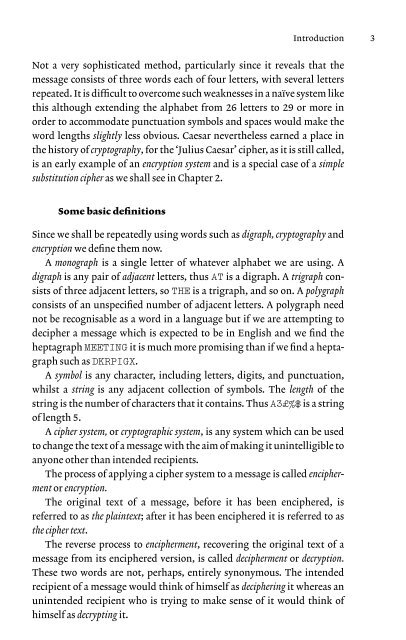Code and ciphers: Julius Caesar, the Enigma and the internet
Code and ciphers: Julius Caesar, the Enigma and the internet
Code and ciphers: Julius Caesar, the Enigma and the internet
You also want an ePaper? Increase the reach of your titles
YUMPU automatically turns print PDFs into web optimized ePapers that Google loves.
Not a very sophisticated method, particularly since it reveals that <strong>the</strong><br />
message consists of three words each of four letters, with several letters<br />
repeated. It is difficult to overcome such weaknesses in a naïve system like<br />
this although extending <strong>the</strong> alphabet from 26 letters to 29 or more in<br />
order to accommodate punctuation symbols <strong>and</strong> spaces would make <strong>the</strong><br />
word lengths slightly less obvious. <strong>Caesar</strong> never<strong>the</strong>less earned a place in<br />
<strong>the</strong> history of cryptography, for <strong>the</strong> ‘<strong>Julius</strong> <strong>Caesar</strong>’ cipher, as it is still called,<br />
is an early example of an encryption system <strong>and</strong> is a special case of a simple<br />
substitution cipher as we shall see in Chapter 2.<br />
Some basic definitions<br />
Introduction 3<br />
Since we shall be repeatedly using words such as digraph, cryptography <strong>and</strong><br />
encryption we define <strong>the</strong>m now.<br />
A monograph is a single letter of whatever alphabet we are using. A<br />
digraph is any pair of adjacent letters, thus AT is a digraph. A trigraph consists<br />
of three adjacent letters, so THE is a trigraph, <strong>and</strong> so on. A polygraph<br />
consists of an unspecified number of adjacent letters. A polygraph need<br />
not be recognisable as a word in a language but if we are attempting to<br />
decipher a message which is expected to be in English <strong>and</strong> we find <strong>the</strong><br />
heptagraph MEETING it is much more promising than if we find a heptagraph<br />
such as DKRPIGX.<br />
A symbol is any character, including letters, digits, <strong>and</strong> punctuation,<br />
whilst a string is any adjacent collection of symbols. The length of <strong>the</strong><br />
string is <strong>the</strong> number of characters that it contains. Thus A3£%$ is a string<br />
of length 5.<br />
A cipher system, or cryptographic system, is any system which can be used<br />
to change <strong>the</strong> text of a message with <strong>the</strong> aim of making it unintelligible to<br />
anyone o<strong>the</strong>r than intended recipients.<br />
The process of applying a cipher system to a message is called encipherment<br />
or encryption.<br />
The original text of a message, before it has been enciphered, is<br />
referred to as <strong>the</strong> plaintext; after it has been enciphered it is referred to as<br />
<strong>the</strong> cipher text.<br />
The reverse process to encipherment, recovering <strong>the</strong> original text of a<br />
message from its enciphered version, is called decipherment or decryption.<br />
These two words are not, perhaps, entirely synonymous. The intended<br />
recipient of a message would think of himself as deciphering it whereas an<br />
unintended recipient who is trying to make sense of it would think of<br />
himself as decrypting it.

















